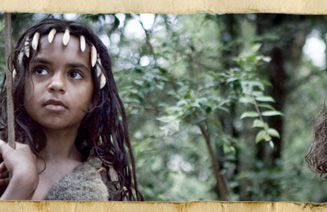Discover
- As a class, view the clip and discuss the relationship between Aunty and the children. The clip illustrates the education of Indigenous children through oral traditions such as storytelling. Oral communication of Indigenous groups has been translated through many different mediums such as message sticks, rock and sand art, carvings, body painting, dance and song. More contemporary stories and information are passed on through visual arts, songs, performance art, multimedia and literature such as prose, poetry and plays.
-
In Episode 26 | 1778: Before Time: Barangaroo there is a competition between Barangaroo and her friend to see who is best at mimicking local animals through dance. Ask students to think about other ways they could transfer information about these animals, such as through the painting, dance or song. Divide the class into small groups and give each group three cards with the name of a different Australian animal on each. The cards can be made by pasting the template provided in Student Activity Sheet H26.2: Let's dance on a sheet of cardboard, and cutting out each card. You may wish to include an image of the animal on the back of each card to ensure all students know what the animal looks like.
- In small groups, students should come up with creative ideas for how they could communicate the animals on the cards to the rest of the group without using words. Ask each group in turn to share their ideas with the class and have the rest of the students guess which animal they are trying to portray. At the end of this activity, discuss with students how body language, sign language and facial expressions can be used to convey meaning.
- Dance is an important means by which all cultural groups, including Indigenous people, pass on knowledge, including spiritual stories and sacred knowledge. For many Indigenous people this knowledge is only available to and appropriate for particular people and not for public knowledge.
- Show the class the introduction to the film Ceremony: the Djungguwan of Northeast Arnhem Land (2006), which documents the 'law ceremony' of the Yolgnu people. The Yolgnu have shared some of their ceremony and it should be presented and discussed respectfully. Be sure to read the teacher notes:
Film Australia, 'Ceremony: the Djungguwan of Northeast Arnhem Land', filmaustraliaceremony.com.au/pdf/teachers_notes.pdf
Background knowledge and information to ensure students have the context to discuss this ceremony appropriately
- Ask students to answer the following questions as they watch:
- How do the Yolgnu people pass on their sacred knowledge?
- What is the Djungguwan ceremony teaching?
- What is the story being told in the ceremony?
- Once they have formulated their answers, ask students to discuss them with a partner. Finally, ask students to share their answers with the class.
Reflect
-
Ask students to find out about a ceremony from their own or another religious or cultural group in Australia that may be shared as public knowledge. They should research the ceremony and reflect on how it sounds, looks and feels to be involved. It may be a ceremony that they have been a part of in some way, one they can ask their family or wider community about or one that they can research on the internet. Students can use the Y-chart provided in Student Activity Sheet H26.2: Let's dance to record their findings.
1
What does it sound like?
- Once students have researched and found out as much as they can about the ceremony, ask them to record the sounds they would hear during the performance of the ceremony. They should list these in the relevant section of the Y-chart.
2
What does it look like?
- As students will have seen, meaning and messages at ceremonies can be transmitted through many different forms such as song, dance, dress, body painting and art. Body paint, for example, is used to help communicate the story in many Indigenous ceremonies. Students should list examples in the relevant section of the Y-chart.
3
What does it feel like?
- Invite students to experience what it feels like to be dressed up and performing as part of such a ceremony. Talk to people who have taken part, watch videos or read about the ceremonies. Students should list how it feels in the relevant section of the Y-chart.
- Encourage students to share what they have found out about their ceremonies and display the Y-charts for discussion.
- Within Australia today, there are many Indigenous dance groups who keep the tradition of dance ceremonies alive. There may be some in your local area that you could find out about and invite to perform or conduct workshops. Many of these groups have websites which your students can explore:
-
Bangarra Dance Theatre, www.bangarra.com.au/
-
Descendance, 'Aboriginal and Torres Strait Islander Dance Theatre', www.descendance.com.au/
-
Tjapukai Aboriginal Cultural Park, www.tjapukai.com.au/
- Divide students into groups of eight and ask them to find out about a local, state or national Indigenous festival.
- Each group could develop a poster advertising the festival, including what it looks, sounds and feels like, to encourage people to attend, or choreograph a short dance that imitates the movements of an Australian animal.
Download
Student Activity Sheet H26.2: Let's dance



![Dance-off [Episode 26 | Before Time : Barangaroo] Dance-off [Episode 26 | Before Time : Barangaroo]](/assets/interface/images/spec_graphic/clip/beforetime02barangaroo/1/thumb.jpg)
![Yabbies [Episode 26 | Before Time : Barangaroo] Yabbies [Episode 26 | Before Time : Barangaroo]](/assets/interface/images/spec_graphic/clip/beforetime02barangaroo/2/thumb.jpg)


